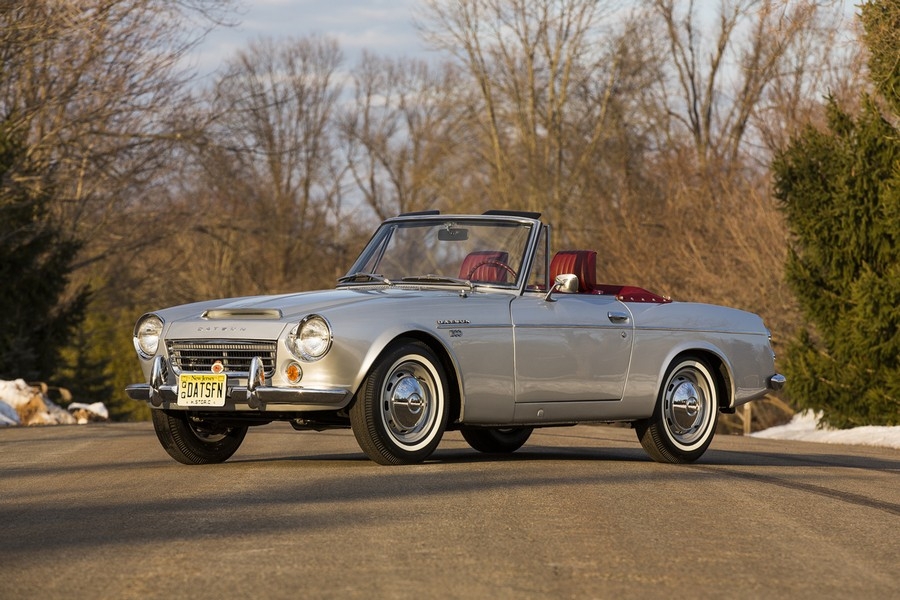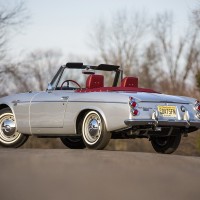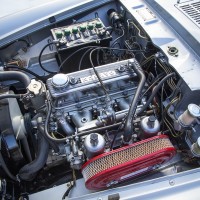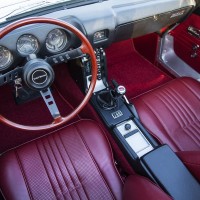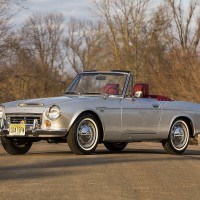This car
This Datsun 1600 SPL311 is a perfect example of the model. Appearing here in its original colors of Silver Grey Metallic (code #666) and smart red vinyl bucket seats, this roadster was meticulously restored last year. Originally purchased in Arizona, the car was quite original at the commencement of the restoration and is what might affectionately be called a “true survivor.” The Datsun was totally disassembled, the body stripped and repainted, and then finished to replicate the factory-original presentation. All components were inspected and refurbished to original specifications, with the majority of NOS and replacement parts obtained direct from Datsun Parts in Northridge, CA. The brightwork was replated by Frankford Plating in Philadelphia, PA, and Trim Specialties of Lambertville, NJ, was commissioned to install the canvas convertible top and correct vinyl interior in complementary red. Several desirable upgrades were made to the car during restoration, including the installation of a Datsun 5-speed manual transmission to facilitate highway cruising, and a hidden radio amplifier to make that cruising ultimately more enjoyable. The car has accrued approximately 42,000 miles, and only 1,000 since the completion of the restoration. The consignor has entered the roadster in several events and notably has won First in Class and Best in Show at the Datsun Region Meet at Watkins Glen and the Antique Automobile Club of America Senior Award at Hershey in 2013, after which it was requested for display at the AACA Museum. Numerous awards, badges, and trophies accompany the sale of the car. The 1600 roadster is additionally accompanied by its original data plate, documented photo history of the restoration with receipts and records, and several original Datsun publications as well as its original transmission.SCM Analysis
Detailing
| Vehicle: | 1968 Datsun 1600 Roadster |
| Number Produced: | 31,350 |
| Original List Price: | $2,766 |
| Tune Up Cost: | $200 |
| Distributor Caps: | $68 |
| Chassis Number Location: | Right side firewall |
| Engine Number Location: | Right side firewall |
| Club Info: | Datsun Sport Roadsters |
| Website: | http://www.311s.org |
| Investment Grade: | C |
his car, Lot 6, sold for $50,600, including buyer’s premium, at Gooding & Company’s Amelia Island, FL, sale on March 8, 2013.
There’s something about high-end car auctions that makes people lose their sense of proportion. When you see people bidding into the millions of dollars on one-of-a-kind vehicles, spending a measly $50,600 on a nice sports car may seem like a screaming bargain. That’s the only rational way to describe what happened at Amelia Island with this lovely little Datsun 1600.
The best in the world?
First, let’s acknowledge that this is without a doubt an expert restoration on an attractive, classic sports car. The restorers clearly spared no expense — the exterior and interior fit and finish is at least as good as the day it was delivered from the factory. The car has been carefully resprayed in its original color. The engine bay is clean and stock, as is the trunk. Even the retrofitted 5-speed transmission — sourced from the more-powerful 2000 roadster — has been nicely integrated, with a matching shift pattern on the console.
This is deservedly an award-winning car — possibly the best Datsun roadster outside of the Nissan museum.
Yes, this may be the best Datsun roadster in the world, but it’s still a Datsun roadster. Whether you call this car an SPL311, a Fairlady, or just the Datsun 1600, this model has never received the recognition it deserves from the sports car community.
There’s little on an MGB of the same year that is not equaled or exceeded by the Datsun. Net horsepower was identical at 95. Where MG delivered a straight-cut first gear until 1968, Datsun gave you four synchronized gears from the beginning of the 1600 line in 1965. The MG was just over $100 cheaper in 1968, but the two cars are alike in so many ways that it’s hard to explain why the Datsun never caught on. The SCM Price Guide lists the price range for the MGB at $10,000–$16,000, which is substantially higher than the $6,000–$12,500 range expected for the Datsun. SCM gives the MG a higher investment grade as well.
A stratospheric result
All this is a lot of insider baseball, but it points to the central question — why did this Datsun, as nice as it is, rate a purchase price of $50,600? There’s nothing in auction history that comes close to this price.
The previous high-water mark for the Datsun 1600 roadster was $20,350 in 2012 — and the same car had sold previously in 2004 for $6,400. In the entire SCM Platinum Auction Database, only five Datsun 1600 roadsters have ever exceeded $10,000, and only two have exceeded $15,000.
Among the more powerful — and far less common — 2000 roadsters, the high bid (but no sale) for a top-flight car was $45,000 in 2010, yet a very nice condition 2 car sold the following year for just $8,250.
Catching a rising tide?
So what’s the rationale for the incredible price of this sale — a lot of cocktails and some sentimental memories? Perhaps, but it’s more likely that the buyer sees the day coming when having the very best Datsun roadster left in the world will be worth that kind of money. Enthusiasts have long predicted that these cars would eventually rise in value as collectors finally recognize their appeal, and the true believers have been waiting a long time to be proven right. Maybe their moment has finally come?
Honestly, it seems likely that there’s a more subtle market force at work. This feels like another case of the very best cars taking off for stratospheric prices, while the vast majority of condition 2 and condition 3 cars will see prices remaining fairly constant — languishing around $6,000.
We will soon get another clue to this puzzle, as this auction result should bring a few more nicely kept 1600 and 2000 roadsters out of hibernation and across the block. We’ll keep an eye out for those cars in Monterey this summer, but until then, let’s call this one very well sold. ♦
(Introductory description courtesy of Gooding & Company.)
